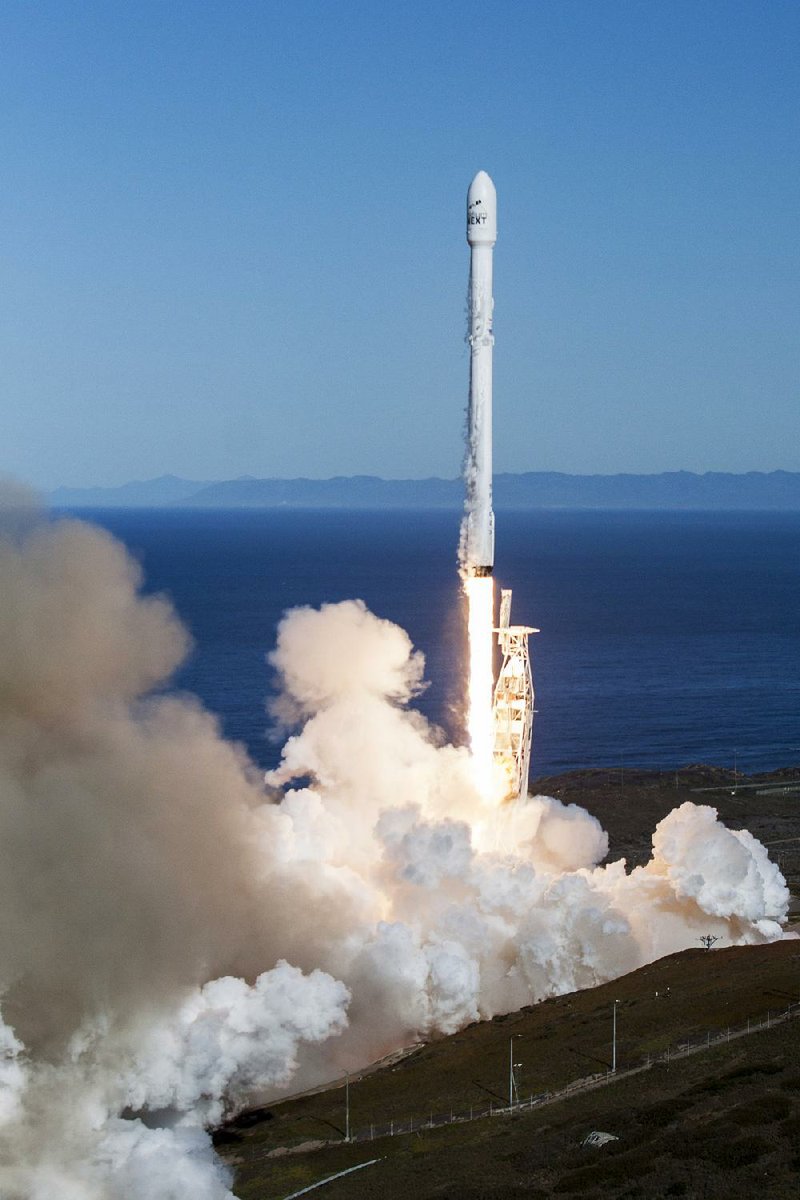LOS ANGELES -- A SpaceX Falcon 9 rocket blasted off from California on Saturday and placed a constellation of satellites in orbit, marking the company's first launch since a fireball engulfed a similar rocket on a Florida launchpad more than four months ago.
The two-stage rocket lifted off from Vandenberg Air Force Base at 9:54 a.m. carrying a payload for Iridium Communications Inc., which is replacing its entire global network with 70 next-generation satellites.
The satellites were deployed about an hour after launch.
About nine minutes after the rocket blasted off, to cheers from the control room, its jettisoned first stage landed upright on a so-called drone ship in the Pacific Ocean south of Vandenberg -- part of SpaceX's effort to make boosters reusable.
The company has succeeded six times previously with landings on a barge or ashore.
A camera aboard the first stage gave viewers a you-are-there experience as it returned to Earth, flared landing rockets and made a perfect upright touchdown on the floating pad.
The return to flight is an important step for SpaceX, billionaire Elon Musk's California company that has about 70 launches in line, worth more than $10 billion. In addition to commercial launches, SpaceX ferries supplies to the International Space Station and is developing a Falcon capable of carrying astronauts to the station.
On Friday, The Wall Street Journal reported that SpaceX had lost $260 million in 2015 after the earlier accident, and revenue dropped 6 percent to $945 million. In earlier years, SpaceX officials including Musk described the company as consistently profitable; that claim has been removed from SpaceX's website.
Company officials did not dispute the numbers reported in The Wall Street Journal article, but portrayed a rosy future.
"Since 2002, we have been at the forefront of revolutionizing space technology, with a solid track record of success, strong customer relationships and more than 70 future launches on our manifest, representing over $10 billion in contracts," Bret Johnsen, SpaceX's chief financial officer, said in a statement. "Furthermore, with over $1 billion in cash reserves and no debt, the company is in a financially strong position and is well positioned for future growth."
SpaceX hopes to launch its larger Falcon Heavy this spring. The Heavy, years behind schedule, would become the world's most powerful rocket since NASA retired the Saturn 5 more than 40 years ago.
SpaceX also plans to refly one of its recovered boosters this spring. By reusing instead of throwing away rocket boosters, SpaceX hopes to significantly reduce the cost of launches.
Also on the schedule is an in-flight abort test of SpaceX's Dragon 2 capsule, a crucial safety prerequisite that it must conduct before the company can begin ferrying NASA astronauts to the space station next year.
SpaceX officials say they identified all possible causes of the Sept. 1 accident during prelaunch testing at Cape Canaveral Air Force Station, Fla., and took corrective action.
The accident destroyed the rocket and its payload -- a satellite that Facebook wanted to use to spread Internet access in Africa -- and grounded the Falcon 9 program during an investigation.
SpaceX announced this month that investigators concluded the accident involved a failure of one of three helium tanks inside the rocket's second-stage liquid oxygen tank.
The investigation involved the Air Force, NASA, the National Transportation Safety Board and the Federal Aviation Administration, which issued a license for the launch.
The September accident was the second time a Falcon 9 was destroyed. In June 2015, a Falcon loaded with space station supplies disintegrated shortly after liftoff. SpaceX determined that a support strut broke.
The 10 satellites launched Saturday are part of McLean, Va.-based Iridium's project to replace its existing network of satellites that provide global voice and data communications.
The program, called Iridium Next, was not only delayed by the SpaceX accident but again most recently as a storm headed into California last weekend.
Iridium plans six more Falcon 9 launches, each carrying 10 satellites, as part of a technology upgrade expected to be completed in 2018.
SpaceX's effort to recover Falcon first stages is intended to reduce costs by recycling a major piece of the launch system.
The first stage contains tanks for liquid oxygen and kerosene as well as nine engines that power the rocket and payload into space, then separates 2½ minutes into flight as the single-engine second stage ignites and continues on to place payloads in the proper orbit.
The first Falcon booster to land safely back on Earth now stands outside the company's headquarters.
Information for this article was contributed by John Antczak of The Associated Press and by Kenneth Chang of The New York Times.
A Section on 01/15/2017
